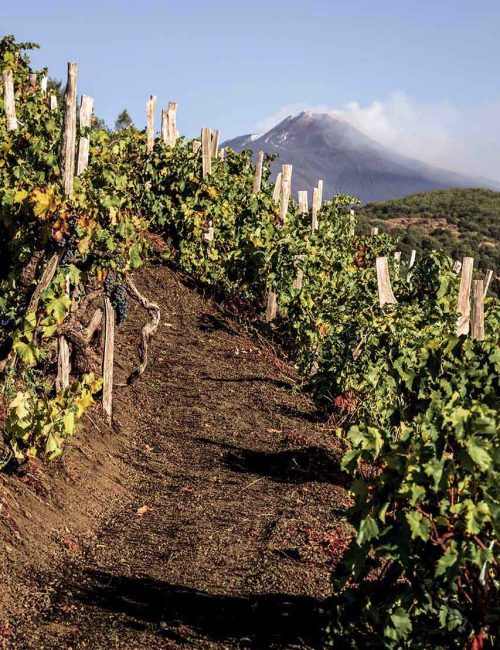
It was a hot August night, and we were in the mood for something refreshing and a little different. After all, there’s a world of fascinating wines out there, so why always drink the same thing? So, we picked a wine made from an obscure native white grape grown on the slopes of Sicily’s Mount Etna.
- But wait, say you, doesn’t Sicily produce only mediocre red wines? Wrong on both counts – it produces some excellent, good value wines, including crisp, refreshing whites. Sicilian wines are produced in several distinct appellations, in addition to the island-wide Sicilia DOC.
- True, Sicilian wines had a deservedly poor reputation for many years, but a renewed focus on quality in recent decades has turned that around. A group of young, innovative winemakers has brought its knowledge and financial capital to a once moribund appellation in a quest to produce the next great wine.
Mount Etna is a unique “wine island” within the island of Sicily. It rises 11,000 feet above sea level, and the climate at its highest viticultural elevations resembles that of the cooler regions of northern Italy. That despite the fact that Catania, at the foot of Mount Etna, is Sicily’s hottest city. Red wines dominate Etna’s lower elevations, but from about 2,000 to 4,000 feet vineyards produce crisp, aromatic whites.
- Etna is an active volcano that constantly spews out lava and volcanic ash, and its volcanic soils make powerful, elegant, and minerally wines.
- Mount Etna contains its own appellation, Etna DOC. It produces white (“Bianco”), red (“Rosso”) and Rosato (rosé) wines. Etna DOC wines tend to be a bit more expensive than other Sicilian wines, but worth the price.
- Etna’s premier white grape is Carricante, which tends to produce low alcohol, high acid wines reminiscent of Alsatian Riesling. It’s often blended with other native grapes to provide greater complexity, so you probably won’t see that name on the label. Wines labeled “Etna Bianco DOC” must contain at least 60 percent Carricante, and Etna Bianco Superiore DOC wines must contain at least 80 percent.
- Etna DOC wine labels may include a “contrade” name (identifying a small plot of historic or cultural significance). These single-vineyard wines often are considered high quality “cru” wines.
Our featured wine is the 2023 Tenuta delle Terre Nere Etna Bianco ($25 – $30 retail). We’re big fans of Tenute delle Terre Nere, which was founded in 2003 by one of the pioneers of quality Etna DOC wines, American-born wine merchant Marco de Grazia. This wine did not disappoint. This aromatic Etna Bianco is a blend of about seventy percent Carricante, along with several other obscure, and largely unpronounceable, native grapes. It’s produced from 50 – 80 year old vines, which tend to produce more concentrated, higher-quality wine.
- This pale yellow wine has pleasing aromas of honeysuckle, white flowers, and citrus. On the palate, it has notes of green apple and citrus, with a tartness from its high acidity and a distinct minerality. This is nicely balanced, moderately complex wine that has an enticing medium-length finish.
- It’s best served chilled (55 degrees) and makes a great aperitif. Or, it pairs nicely with prosciutto and melon, fish, or chicken.
- While this wine is generally available, if you can’t find it Planeta is another great Etna producer.
Cheers!

Sounds yummy! Your description sounds like a white wine I had last night from Griva Vineyard in Soledad CA. It’s called Kori.